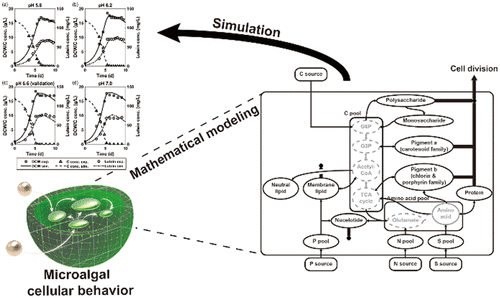当前位置:
X-MOL 学术
›
Ind. Eng. Chem. Res.
›
论文详情
Our official English website, www.x-mol.net, welcomes your
feedback! (Note: you will need to create a separate account there.)
Mathematical Modeling of Microalgal Internal Metabolic Behaviors under Heterotrophic Conditions and Its Application
Industrial & Engineering Chemistry Research ( IF 3.8 ) Pub Date : 2020-01-14 , DOI: 10.1021/acs.iecr.9b05948 Kyung Hwan Ryu 1 , Boeun Kim 1 , Seongmin Heo 1 , Yong-Keun Chang 1, 2 , Jay H. Lee 1
Industrial & Engineering Chemistry Research ( IF 3.8 ) Pub Date : 2020-01-14 , DOI: 10.1021/acs.iecr.9b05948 Kyung Hwan Ryu 1 , Boeun Kim 1 , Seongmin Heo 1 , Yong-Keun Chang 1, 2 , Jay H. Lee 1
Affiliation

|
Heterotrophic cultivation can be a preferred option for commercial microalgal biorefinery owing to its significantly higher productivity and lipid content leading to high value products. However, limited modeling works have been carried out on heterotrophic culturing of microalgae so far. In this research, a mathematical model is developed to describe microalgae’s metabolic behavior under heterotrophic conditions with their internal components classified into nine types (nucleotides, amino acids, proteins, polysaccharides, monosaccharides, membrane lipids, neutral lipids, and pigments including carotenoid and chlorine families). The modeling is intended to be general as the objective is to build an overarching model capable of describing microalgal behavior for a wide variety of microalgal species. However, the general model turns out to be nonparsimonious, containing a very large number of parameters, which complicates parameter estimation and optimization in its applications. To assist in applications, a model reduction procedure is suggested and demonstrated using two example cases. Therefore, the result is an overarching general model, which can be tailored to specific types of applications at hand, circumventing the need to develop a new model from scratch for each new type of application. The model can be used to improve the design and operation of a microalgal cultivation process with respect to specific targeted products, thereby contributing to the enhanced economic feasibility and sustainability of microalgal biorefinery.
中文翻译:

异养条件下微藻内部代谢行为的数学模型及其应用
异养栽培由于其显着更高的生产率和脂质含量而导致高价值产品,因此可作为商业微藻生物精炼厂的优选选择。然而,迄今为止,关于微藻的异养培养已经进行了有限的建模工作。在这项研究中,建立了一个数学模型来描述微藻在异养条件下的代谢行为,其内部成分分为九种类型(核苷酸,氨基酸,蛋白质,多糖,单糖,膜脂质,中性脂质以及包括类胡萝卜素和氯家族的色素) )。该建模旨在成为通用模型,因为目标是建立一个能够描述各种微藻物种的微藻行为的总体模型。然而,通用模型证明是非简约的,包含大量参数,这使应用中的参数估计和优化变得复杂。为了协助应用,提出了模型简化程序,并使用两个示例案例进行了演示。因此,结果是一个总体通用的模型,可以针对手头的特定类型的应用程序进行定制,从而避免了为每种新型应用程序从头开发新模型的需求。该模型可用于针对特定目标产品改善微藻培养过程的设计和操作,从而有助于提高微藻生物精炼厂的经济可行性和可持续性。这使得其应用中的参数估计和优化变得复杂。为了协助应用,提出了模型简化程序,并使用两个示例案例进行了演示。因此,结果是一个总体的通用模型,可以针对现有的特定类型的应用程序进行定制,从而避免了为每种新型应用程序从头开发新模型的需求。该模型可用于针对特定目标产品改善微藻培养过程的设计和操作,从而有助于提高微藻生物精炼厂的经济可行性和可持续性。这使得其应用中的参数估计和优化变得复杂。为了协助应用,提出了模型简化程序,并使用两个示例案例进行了演示。因此,结果是一个总体的通用模型,可以针对现有的特定类型的应用程序进行定制,从而避免了为每种新型应用程序从头开发新模型的需求。该模型可用于针对特定目标产品改善微藻培养过程的设计和操作,从而有助于提高微藻生物精炼厂的经济可行性和可持续性。可以针对手头的特定类型的应用程序进行量身定制,从而避免了为每种新型应用程序从头开发新模型的需求。该模型可用于针对特定目标产品改善微藻培养过程的设计和操作,从而有助于提高微藻生物精炼厂的经济可行性和可持续性。可以针对手头的特定类型的应用程序进行量身定制,从而避免了为每种新型应用程序从头开发新模型的需求。该模型可用于针对特定目标产品改善微藻培养过程的设计和操作,从而有助于提高微藻生物精炼厂的经济可行性和可持续性。
更新日期:2020-01-15
中文翻译:

异养条件下微藻内部代谢行为的数学模型及其应用
异养栽培由于其显着更高的生产率和脂质含量而导致高价值产品,因此可作为商业微藻生物精炼厂的优选选择。然而,迄今为止,关于微藻的异养培养已经进行了有限的建模工作。在这项研究中,建立了一个数学模型来描述微藻在异养条件下的代谢行为,其内部成分分为九种类型(核苷酸,氨基酸,蛋白质,多糖,单糖,膜脂质,中性脂质以及包括类胡萝卜素和氯家族的色素) )。该建模旨在成为通用模型,因为目标是建立一个能够描述各种微藻物种的微藻行为的总体模型。然而,通用模型证明是非简约的,包含大量参数,这使应用中的参数估计和优化变得复杂。为了协助应用,提出了模型简化程序,并使用两个示例案例进行了演示。因此,结果是一个总体通用的模型,可以针对手头的特定类型的应用程序进行定制,从而避免了为每种新型应用程序从头开发新模型的需求。该模型可用于针对特定目标产品改善微藻培养过程的设计和操作,从而有助于提高微藻生物精炼厂的经济可行性和可持续性。这使得其应用中的参数估计和优化变得复杂。为了协助应用,提出了模型简化程序,并使用两个示例案例进行了演示。因此,结果是一个总体的通用模型,可以针对现有的特定类型的应用程序进行定制,从而避免了为每种新型应用程序从头开发新模型的需求。该模型可用于针对特定目标产品改善微藻培养过程的设计和操作,从而有助于提高微藻生物精炼厂的经济可行性和可持续性。这使得其应用中的参数估计和优化变得复杂。为了协助应用,提出了模型简化程序,并使用两个示例案例进行了演示。因此,结果是一个总体的通用模型,可以针对现有的特定类型的应用程序进行定制,从而避免了为每种新型应用程序从头开发新模型的需求。该模型可用于针对特定目标产品改善微藻培养过程的设计和操作,从而有助于提高微藻生物精炼厂的经济可行性和可持续性。可以针对手头的特定类型的应用程序进行量身定制,从而避免了为每种新型应用程序从头开发新模型的需求。该模型可用于针对特定目标产品改善微藻培养过程的设计和操作,从而有助于提高微藻生物精炼厂的经济可行性和可持续性。可以针对手头的特定类型的应用程序进行量身定制,从而避免了为每种新型应用程序从头开发新模型的需求。该模型可用于针对特定目标产品改善微藻培养过程的设计和操作,从而有助于提高微藻生物精炼厂的经济可行性和可持续性。











































 京公网安备 11010802027423号
京公网安备 11010802027423号